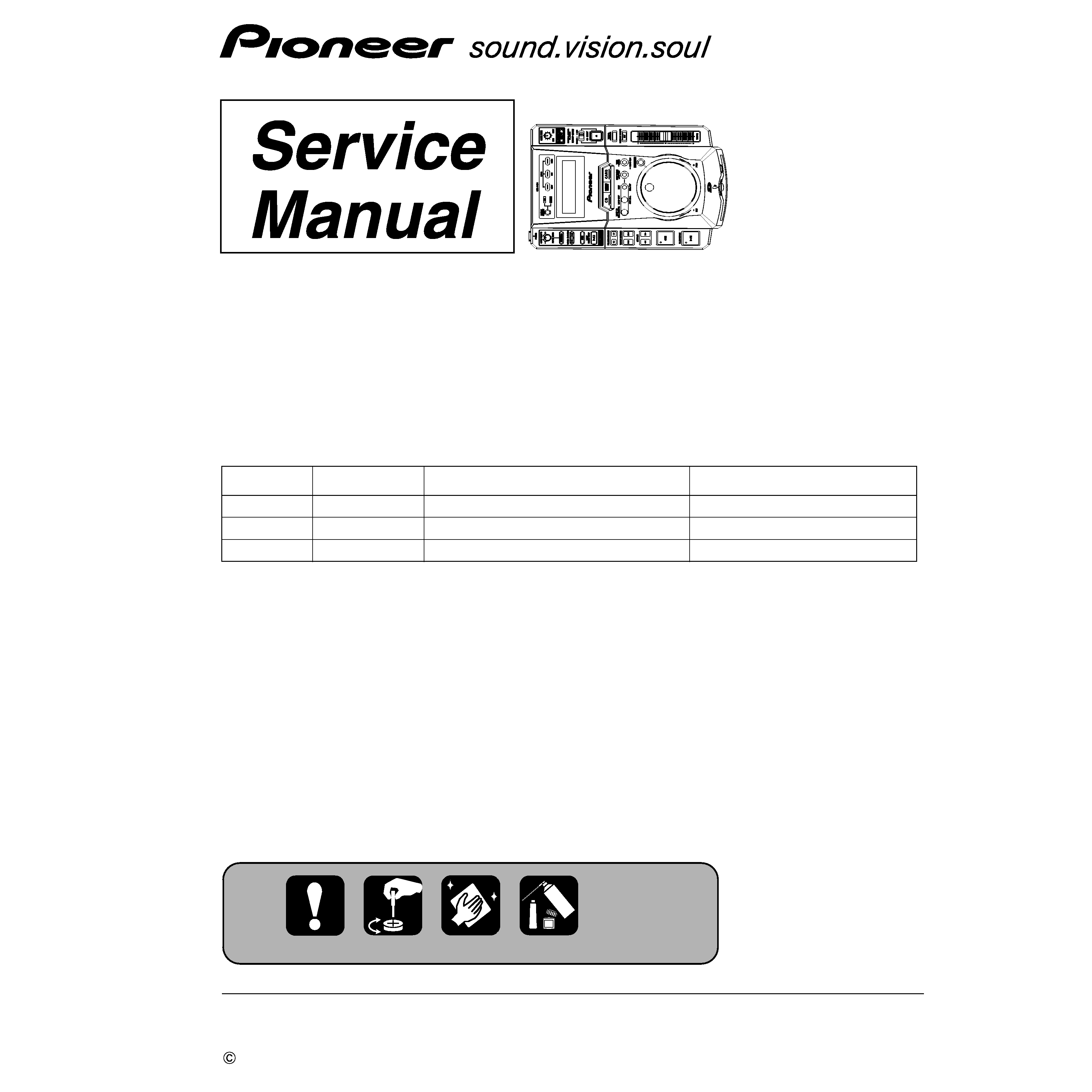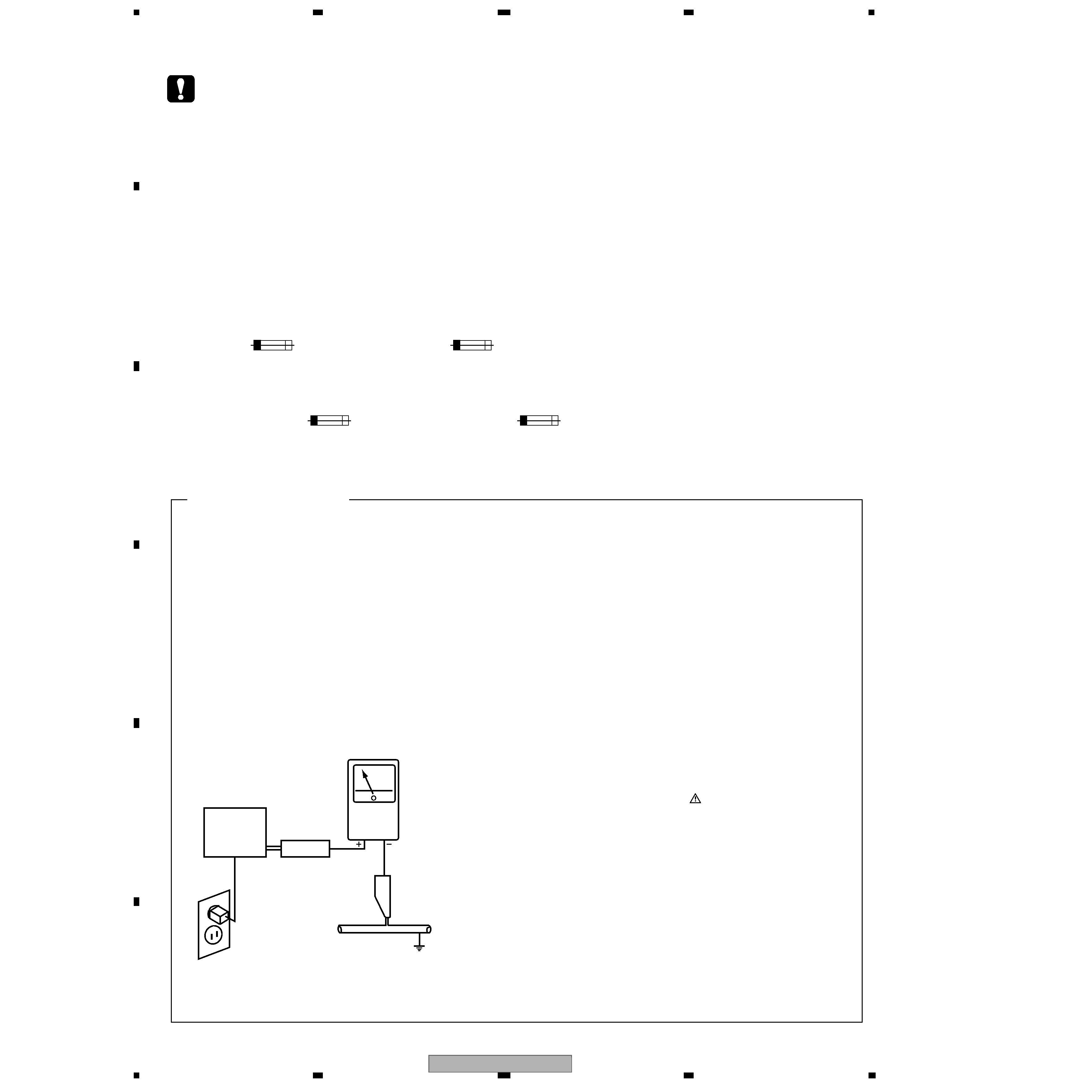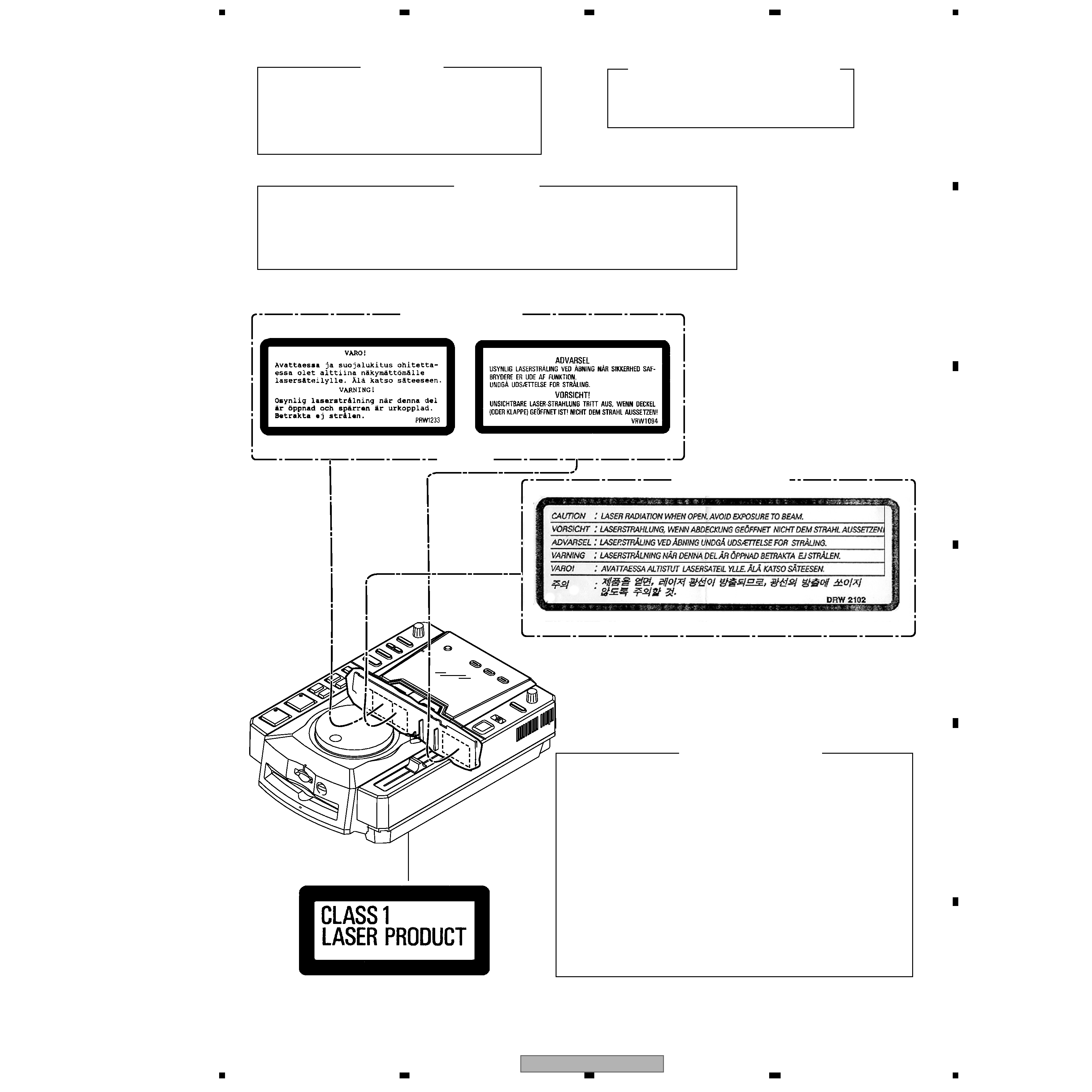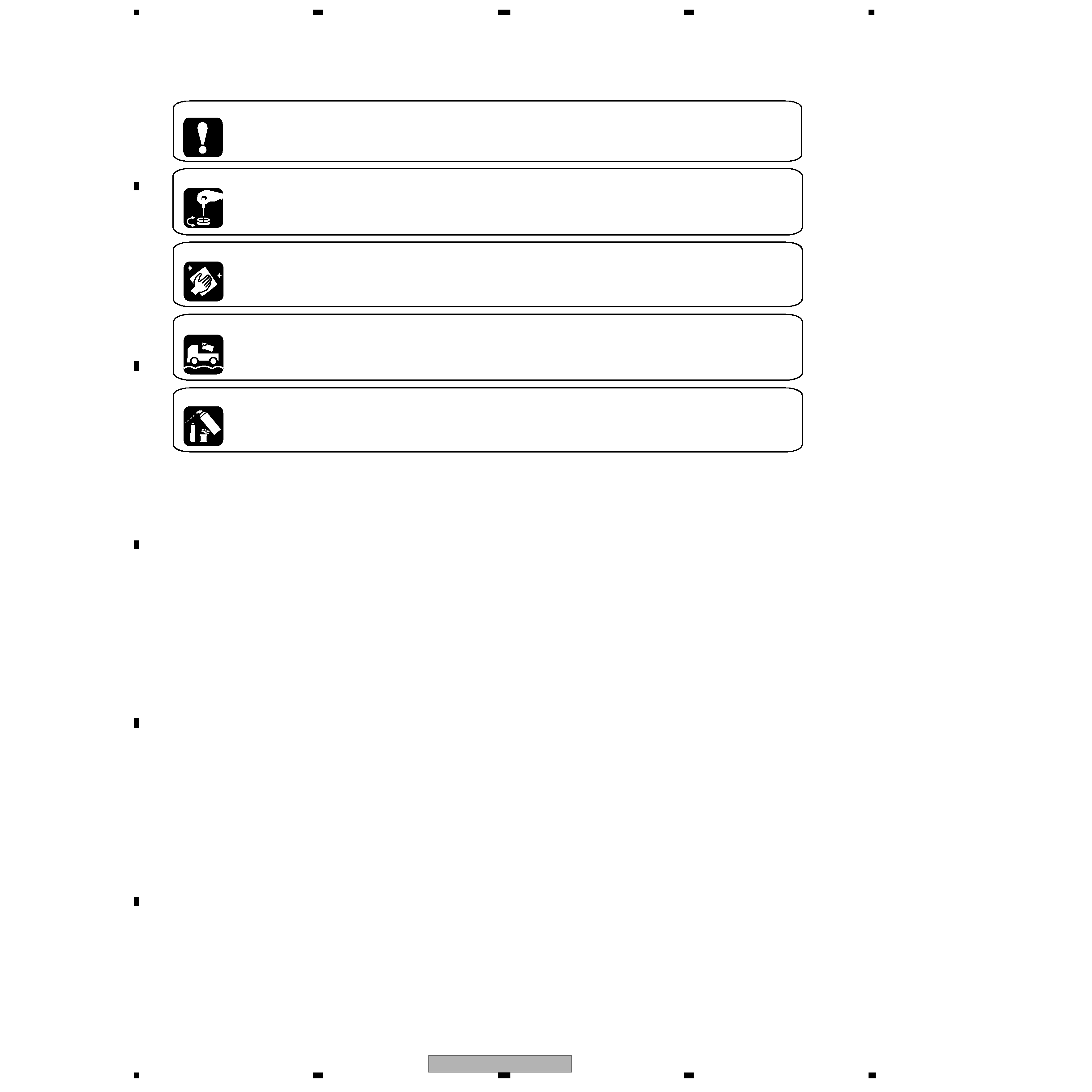
ORDER NO.
PIONEER CORPORATION 4-1, Meguro 1-chome, Meguro-ku, Tokyo 153-8654, Japan
PIONEER ELECTRONICS (USA) INC. P.O. Box 1760, Long Beach, CA 90801-1760, U.S.A.
PIONEER EUROPE NV Haven 1087, Keetberglaan 1, 9120 Melsele, Belgium
PIONEER ELECTRONICS ASIACENTRE PTE. LTD. 253 Alexandra Road, #04-01, Singapore 159936
PIONEER CORPORATION 2002
DMP-555
RRV2604
DIGITAL MEDIA PLAYER
DMP-555
THIS MANUAL IS APPLICABLE TO THE FOLLOWING MODEL(S) AND TYPE(S).
Model
Type
Power Requirement
Remarks
DMP-555
KUC
AC120V
DMP-555
TL
AC110-240V
DMP-555
WY
AC220-240V
For details, refer to "Important symbols for good services" on the next page.
T-ZZY JUNE 2002 printed in Japan

DMP-555
2
1234
123
4
C
D
F
A
B
E
SAFTY INFORMATION
This service manual is intended for qualified service technicians ; it is not meant for the casual
do-it-yourselfer. Qualified technicians have the necessary test equipment and tools, and have been
trained to properly and safely repair complex products such as those covered by this manual.
Improperly performed repairs can adversely affect the safety and reliability of the product and may
void the warranty. If you are not qualified to perform the repair of this product properly and safely,
you should not risk trying to do so and refer the repair to a qualified service technician.
WARNING
This product contains lead in solder and certain electrical parts contain chemicals which are known to the state of California to
cause cancer, birth defects or other reproductive harm.
Health & Safety Code Section 25249.6 - Proposition 65
NOTICE
(FOR CANADIAN MODEL ONLY)
Fuse symbols
(fast operating fuse) and/or
(slow operating fuse) on PCB indicate that replacement parts
must be of identical designation.
REMARQUE
(POUR MODÈLE CANADIEN SEULEMENT)
Les symboles de fusible
(fusible de type rapide) et/ou
(fusible de type lent) sur CCI indiquent que les pièces
de remplacement doivent avoir la même désignation.
1. SAFETY PRECAUTIONS
The following check should be performed for the
continued protection of the customer and service
technician.
LEAKAGE CURRENT CHECK
Measure leakage current to a known earth ground
(water pipe, conduit, etc.) by connecting a leakage
current tester such as Simpson Model 229-2 or
equivalent between the earth ground and all exposed
metal parts of the appliance (input/output terminals,
screwheads, metal overlays, control shaft, etc.). Plug
the AC line cord of the appliance directly into a 120V
AC 60Hz outlet and turn the AC power switch on. Any
current measured must not exceed 0.5mA.
ANY MEASUREMENTS NOT WITHIN THE LIMITS
OUTLINED
ABOVE
ARE
INDICATIVE
OF
A
POTENTIAL
SHOCK
HAZARD
AND
MUST
BE
CORRECTED
BEFORE
RETURNING
THE
APPLIANCE TO THE CUSTOMER.
2. PRODUCT SAFETY NOTICE
Many electrical and mechanical parts in the appliance
have special safety related characteristics. These are
often not evident from visual inspection nor the
protection afforded by them necessarily can be obtained
by using replacement components rated for voltage,
wattage, etc. Replacement parts which have these
special safety characteristics are identified in this
Service Manual.
Electrical components having such features are
identified by marking with a
on the schematics and on
the parts list in this Service Manual.
The use of a substitute replacement component which
does not have the same safety characteristics as the
PIONEER recommended replacement one, shown in the
parts list in this Service Manual, may create shock, fire,
or other hazards.
Product Safety is continuously under review and new
instructions are issued from time to time. For the latest
information, always consult the current PIONEER
Service Manual. A subscription to, or additional copies
of, PIONEER Service Manual may be obtained at a
nominal charge from PIONEER.
Leakage
current
tester
Reading should
not be above
0.5mA
Device
under
test
Test all
exposed metal
surfaces
Also test with
plug reversed
(Using AC adapter
plug as required)
Earth
ground
AC Leakage Test
(FOR USA MODEL ONLY)

DMP-555
3
5
678
56
7
8
C
D
F
A
B
E
(VRW1094)
(PRW1233)
1. Laser Interlock Mechanism
The position of the switch (S510) for detecting loading completion
is detected by the system microprocessor, and the design prevents
laser diode oscillation when the switch is not in LPS1 terminal side
(when the mechanism is not clamped and LPS1 signal is high level.)
Thus, the interlock will no longer function if the switch is deliberately
set to LPS1 terminal side. ( if LPS1 signal is low level ).
In the test mode* the interlock mechanism will not function.
Laser diode oscillation will continue, if pin 4 of AN8702NFH (IC800)
on the CDPB ASSY is connected to GND, or else the terminals of
Q600 are shorted to each other (fault condition).
2. When the cover is opened, close viewing of the objective
lens with the naked eye will cause exposure to a Class 1 laser beam.
Additional Laser Caution
* Refer to pages 71.
DMP-555/WY only
DMP-555/TL only
THIS
PIONEER
APPARATUS
CONTAINS
LASER OF CLASS 1.
SERVICING OPERATION OF THE APPARATUS
SHOULD
BE
DONE
BY
A
SPECIALLY
INSTRUCTED PERSON.
MAXIMUM OUTPUT POWER: 5 mW
WAVELENGTH: 780 785 nm
The AEL(accessible emission level) of the laser power output is less then CLASS 1
but the laser component is capable of emitting radiation exceeding the limit for
CLASS 1.
A specially instructed person should servicing operation of the apparatus.
IMPORTANT
LASER DIODE CHARACTERISTICS
WARNING !
(DRW2102)
Printed on the Bottom Plate

DMP-555
4
1234
123
4
C
D
F
A
B
E
[ Important symbols for good services ]
In this manual, the symbols shown-below indicate that adjustments, settings or cleaning should be made securely.
When you find the procedures bearing any of the symbols, be sure to fulfill them:
2. Adjustments
To keep the original performances of the product, optimum adjustments or specification confirmation is indispensable.
In accordance with the procedures or instructions described in this manual, adjustments should be performed.
3. Cleaning
For optical pickups, tape-deck heads, lenses and mirrors used in projection monitors, and other parts requiring cleaning,
proper cleaning should be performed to restore their performances.
5. Lubricants, glues, and replacement parts
Appropriately applying grease or glue can maintain the product performances. But improper lubrication or applying
glue may lead to failures or troubles in the product. By following the instructions in this manual, be sure to apply the
prescribed grease or glue to proper portions by the appropriate amount.For replacement parts or tools, the prescribed
ones should be used.
4. Shipping mode and shipping screws
To protect the product from damages or failures that may be caused during transit, the shipping mode should be set or
the shipping screws should be installed before shipping out in accordance with this manual, if necessary.
1. Product safety
You should conform to the regulations governing the product (safety, radio and noise, and other regulations), and
should keep the safety during servicing by following the safety instructions described in this manual.

DMP-555
5
5
678
56
7
8
C
D
F
A
B
E
CONTENTS
SAFTY INFORMATION ........................................................................................................................................2
1. SPECIFICATIONS .............................................................................................................................................6
2. EXPLODED VIEWS AND PARTS LIST.............................................................................................................7
2.1 PACKING ....................................................................................................................................................7
2.2 EXTERIOR (1/2) SECTION ........................................................................................................................8
2.3 EXTERIOR (2/2) SECTION ......................................................................................................................10
2.4 SLOT-IN MECHANISM SECTION ............................................................................................................12
2.5 TRAVERSE MECHANISM ASSY-S ..........................................................................................................14
3. BLOCK DIAGRAM AND SCHEMATIC DIAGRAM ..........................................................................................16
3.1 BLOCK DIAGRAM ....................................................................................................................................16
3.2 OVERALL WIRING DIAGRAM .................................................................................................................18
3.3 CDPB ASSY (1/2).....................................................................................................................................20
3.4 CDPB (2/2) and SLSW ASSYS ................................................................................................................22
3.5 MAIN ASSY (1/5)......................................................................................................................................24
3.6 MAIN ASSY (2/5)......................................................................................................................................26
3.7 MAIN (3/5) and SDCB ASSYS .................................................................................................................28
3.8 MAIN ASSY (4/5)......................................................................................................................................30
3.9 MAIN ASSY (5/5)......................................................................................................................................32
3.10 TRMB and PSWB ASSYS ......................................................................................................................34
3.11 SW POWER ASSY .................................................................................................................................36
3.12 FLKB, PHTB and JOGB ASSYS ............................................................................................................38
4. PCB CONNECTION DIAGRAM ......................................................................................................................49
4.1 CDPB and SLSW ASSYS.........................................................................................................................50
4.2 MAIN and SDCB ASSYS..........................................................................................................................52
4.3 TRMB ASSYS...........................................................................................................................................56
4.4 PSWB and SW POWER ASSYS ..............................................................................................................58
4.5 FLKB, PHTB and JOGB ASSYS ..............................................................................................................60
5. PCB PARTS LIST ............................................................................................................................................64
6. ADJUSTMENT ................................................................................................................................................68
6.1 ADJUSTMENT ITEMS AND LOCATION ..................................................................................................68
6.2 JIGS AND MEASURING INSTRUMENTS ...............................................................................................68
6.3 NECESSARY ADJUSTMENT POINTS ....................................................................................................68
6.4 ELECTRICAL ADJUSTMENT ..................................................................................................................69
7. GENERAL INFORMATION .............................................................................................................................70
7.1 DIAGNOSIS ..............................................................................................................................................70
7.1.1 CLEANING .........................................................................................................................................70
7.1.2 SERVICE MODE ................................................................................................................................70
7.1.3 ERROR CODE ...................................................................................................................................73
7.1.4 DISASSEMBLY ..................................................................................................................................74
7.2 PARTS ......................................................................................................................................................76
7.2.1 IC........................................................................................................................................................76
8. PANEL FACILITIES .......................................................................................................................................106
